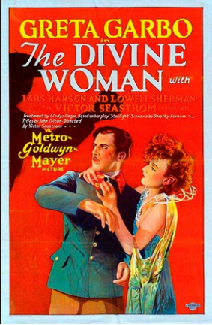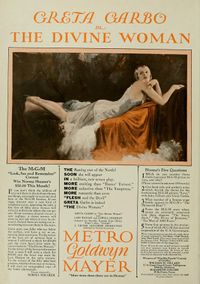The Divine Woman (partially found silent drama film; 1928): Difference between revisions
ObscurusDoom (talk | contribs) (Created page with "{{InfoboxLost |title=<center>The Divine Woman</center> |image=Divine.png |imagecaption=The poster for the movie |status=<span style="color:orange;">'''Partially Found'''</span...") |
ObscurusDoom (talk | contribs) |
||
| Line 38: | Line 38: | ||
{| class="wikitable" style="margin: auto;" | {| class="wikitable" style="margin: auto;" | ||
| {{#ev:youtube|https://www.youtube.com/watch?v=u9jncoaHyWI|256x192|center| | | {{#ev:youtube|https://www.youtube.com/watch?v=u9jncoaHyWI|256x192|center|The surviving nine minute reel.}} | ||
[[Category:Historic|Divine Woman, The (lost silent drama film; 1928]] | [[Category:Historic|Divine Woman, The (lost silent drama film; 1928]] | ||
[[Category:Partially Found|Divine Woman, The (lost silent drama film; 1928]] | [[Category:Partially Found|Divine Woman, The (lost silent drama film; 1928]] | ||
[[Category:Lost Films|Divine Woman, The (lost silent drama film; 1928]] | [[Category:Lost Films|Divine Woman, The (lost silent drama film; 1928]] | ||
Revision as of 22:10, 30 April 2017
The Divine Woman is a 1928 American silent drama film adapted from the successful 1925 Broadway play Starlight, written by Gladys Unger. The film was directed by pioneering Swedish film director, screenwriter,Victor David Sjöström (sometimes known in the United States as Victor Seastrom.) and produced and distributed by Metro-Goldwyn-Mayer.
Greta Garbo
For the film Sjöström teamed up with extremely successful Swedish actress, Greta Garbo. Garbo had three separate nominations for the Academy Award for best actress. In 1954 she later went to receive an Academy Honorary Award for her quote on quote "luminous and unforgettable screen performances." In 1999, The American Film Institute went on to rank her as 5th on their list of the greatest female stars of the Classic Hollywood cinema. Many film enthusiasts have gone on to agree that her performance in The Divine Woman may be one of the best performances in her entire career.
Plot
As previously mentioned the movie is adapted from the 1925 play Starlight by Gladys Unger. The plot being loosely based on stories from the early life of renowned French actress Sarah Bernhardt. In the late 1800's Bernhardt dominated Parisian theaters and soon went on to perform and be in high demand in several countries.
Marianne (played by Garbo) is an impoverished, but beautiful young woman living on a farm in Brittany, France in the 1860's. Tired of living in miserable conditions while being neglected by her parents, she heads off to Paris to seek fortune by fulfilling her dreams of becoming an actress. Once she arrives in Paris she meets and befriends a soldier by the name of Lucien (Played by: Lars Hanson) who is soon to be shipped off to Algiers,Algeria. They hit it off and Lucien offers her a place to stay with a friend of his, an elderly seamstress named Madame Pigonier. (Played by Polly Moran) Within a few weeks Lucien goes off with his regiment.
Around that time she meets a big time theatrical producer by the name of Henry Legrand. (Played by: Lowell Sherman) Legrand is fascinated by Marianne and offers to make her a big stage star. Excited by the idea of becoming a rich and famous star, she soon enough becomes Legrand's Mistress, despite knowing she still loves Lucien. As she devotes herself to Legrand, she rapidly rises to success and soon enough becomes the most successful actress in Paris. Living the life of the rich and famous she didn't know she wanted anything more.
She soon finds Lucien and learns that he deserted himself from the army. As he is on the run from the authorities for his actions, they develop a romantic relationship towards one another. To prove his dedication towards her, he goes out and steals a dress for Marianne. However this only prompts the polices attention and lands him in jail. With Lucien behind bars this makes Marianne have to make a important decision. Did she want to live the life of the rich and famous, devoting herself to a man that wants her but she doesn't want back? Or did she want to wait for the man she loves and drop the life she once knew to live with a poor soldier who she actually loves?
Marianne waits a long time before she has to make her decision. However When Lucien gets out on Parole he finds Marianne and criticizes her. She, still in love with Lucien, renounces her career and goes on to leave Legrande. She goes on to become once again impoverished. However is found by Lucien who saves her from her own self-destruction. They make up for what happened in the past and leave for South America, to start a new life.
Reception
The movie, which was filmed in only a total of 35 days and had 8 reels went on to be premiered on January 14th 1928 in the Capitol theater in New York. The film went on to be shown in different parts of the country. It soon went on to get an international release and has been known to have been shown in Germany, France, Sweden, Poland, and Russia.
Starting out with a budget of $267,000, overall the film only profited $354,000. While it was not a complete flop, the film was not a big success either. Especially with the critics. If anything to most critics, Greta Garbo's role was the only thing keeping the movie from flopping.
One of the several reviewers with this opinion, the magazine Screenland in its February 1927 edition said:
"This picture is a huge disappointment, and, although I am trying to bear up, my emotions get the better of me at times; you see, I counted on Greta Garbo. I rooted myself hoarse for her. The most potent personality on the screen–the girl who made Hollywood actresses look like stock company ingenues the Swedish marvel at emotional massage–she was all of that. And now, just look at The Divine Woman. Here is a new Garbo, who flutters, who mugs. This interestingly reserved lady goes completely Hollywood, all at once. It may have been the part. It may have been the direction–but I don't think so. Miss Garbo seems to me to have only one scene in her usual marvellous quiet manner.... But for the rest–excuse me! “I go now!”
Conservation Status
As of today, The film has been listed by the American Film Institute as "One of the Ten most important lost films of the silent era". This is due only one film reel out of eight, and roughly only nine minutes and forty second of the film having been found. In 1993 at the Gosfilmofond, a Russian film archive in Moscow, Russia, One of the eight reels had been found. The shortest reel to say the least. The contents of reel is now available of the Garbo DVD collection and has been broadcast on 'Turner Classic Movies however with Russian intertitles with English translations under them. The nine minute clip can also be found on Youtube. In late 2010 the Swedish Film Institute found two fragments of the film in their archive which they fully restored and publicly screened on February 27th 2011. As of right now the 9 minute clip is available online while the other two are not publicly available.

